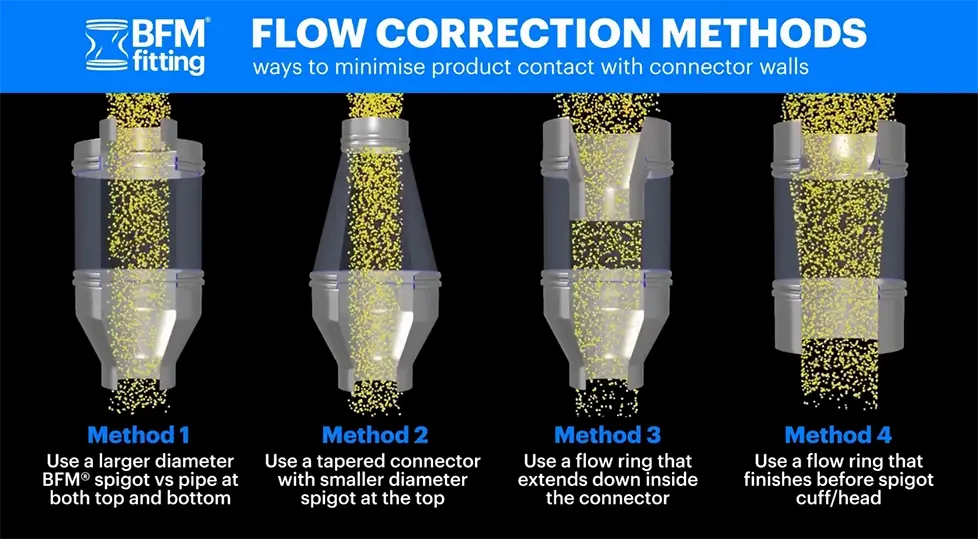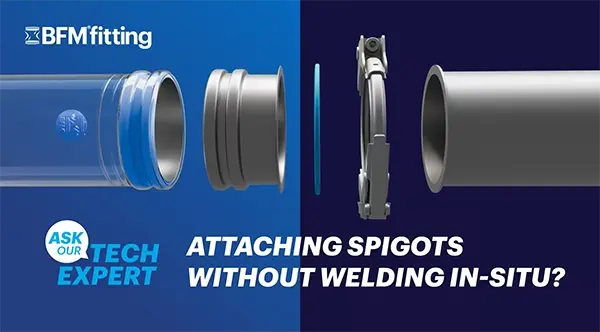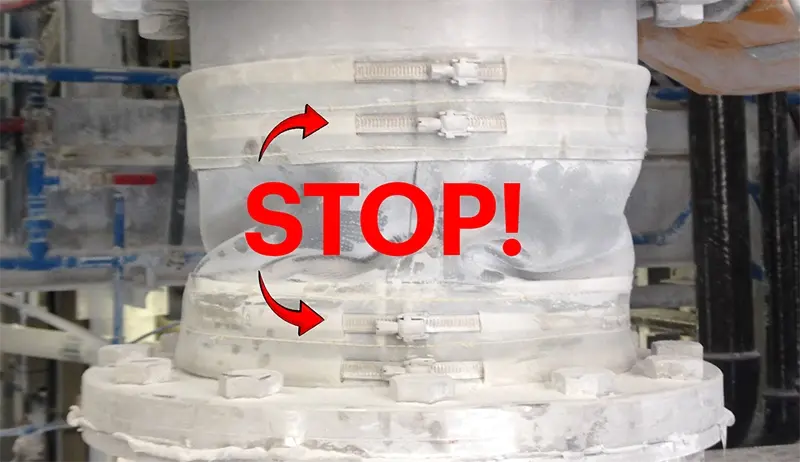Sieves, sifters, screeners, separators, tumblers – however you refer to your powder sifting equipment, in bulk powder processing they are one of the most important steps for ensuring product quality and consistency.
However, they also tend to be one of the most problematic applications when it comes to integrating them seamlessly with your product stream. This is because the constant movement of these machines make them particularly difficult to physically connect with the rest of the production line without leakage or frequent failure at the transition point. This is where the correct installation of quality flexible connectors is vital.
For factory maintenance managers and engineers, ensuring that these connectors are not only correctly installed but also built to last is essential to maintaining operational efficiency and reducing costly downtime.
The Role of Flexible Connectors in Sifters
 Flexible connectors are the unsung heroes in the operation of oscillating and vibrating equipment like sifters and sieves. These connectors bridge the gap between stationary components and the moving sifter, accommodating the aggressive movement while preventing material leakage and maintaining a consistent product flow.
Flexible connectors are the unsung heroes in the operation of oscillating and vibrating equipment like sifters and sieves. These connectors bridge the gap between stationary components and the moving sifter, accommodating the aggressive movement while preventing material leakage and maintaining a consistent product flow.
However, this constant movement, especially in sifters with significant oscillation or "throw," can place considerable stress on the connectors, leading to wear and tear over time.
Manual fastening of connectors with clamps (like those seen on this sifter) often results in variable length and fitment issues, leading to extensive leakage and frequent failures.
Investing in a quality flexible connector system that can handle the physical demands of moving equipment and offers an accurate fitment process can provide long-term benefits.
Importance of Correct Connector Length On Sifters
No matter which flexible connector system you use, one of the most critical factors for the efficient operation of a sifter is ensuring that the flexible connector is the correct length.
The ideal connector should have just enough slack to accommodate the maximum movement. If the connector is too long, it will fold, creating areas prone to abrasion and eventual cracking. Conversely, if it is too short, it can easily tear apart or detach from the equipment under stress.
When measuring to assess the appropriate connector length on a sifter, one important tip is to ensure that you measure during the start-up and shut-down phases of the equipment as well as during operation. This is because the movement at start-up or shut down is often exaggerated (particularly on oscillating equipment), compared to how it behaves during general operation.
It’s vital to find the absolute maximum amount of movement the connector will be expected to absorb at any time.
Factors Affecting Connector Longevity
 To maximize the lifespan of flexible connectors, several factors must be carefully managed:
To maximize the lifespan of flexible connectors, several factors must be carefully managed:
- Pressure Management: Sifters operate under varying pressures that strain the connector walls. Positive pressure pushes walls outward, while negative pressure pulls them inward, causing potential damage. Anti-collapse rings or support structures can reinforce connectors against these pressure fluctuations. Keeping connectors as short as possible also helps minimize pressure effects.
- Temperature Extremes: Operating near the material limits of the connector can lead to it becoming too soft or brittle. Selecting materials that can easily withstand the true product’s temperature range as it passes through it is essential.
- Chemical Exposure: Materials processed through the sifter and cleaning agents used during CIP (Clean In Place) processes can degrade connectors over time. Proper concentration and prompt removal of cleaning agents help minimize chemical damage, extending connector life.
- Extent of Movement: Greater movement of the sifter relative to the connector length increases stress. Accurate measurement of movement and limiting it to within 20% of the connector length helps prevent excessive wear.
- Abrasion from Product Flow: Abrasive products can quickly wear down connectors. Adjusting flow patterns to minimize contact with connector walls can reduce abrasion and extend connector life. This can be achieved by having larger outlet-to-inlet ratios and installing flow control adaptors to funnel product flow away from the connector sides.
Investing in Quality Connectors
.webp?width=405&height=270&name=BFM%20fitting%20system-blue%20arrows-600x400px-1%20(1).webp) Choosing the right flexible connector is an investment in the longevity and efficiency of your sifting operations. High-quality connectors, designed to withstand the demands of oscillating equipment, can significantly reduce maintenance downtime and the frequency of replacements.
Choosing the right flexible connector is an investment in the longevity and efficiency of your sifting operations. High-quality connectors, designed to withstand the demands of oscillating equipment, can significantly reduce maintenance downtime and the frequency of replacements.
The most globally trusted solution in the market is the BFM® fitting system.
Renowned for its superior performance in oscillating, gyrating, and vibratory equipment, the BFM® fitting offers a unique internal snap-fit system that ensures a perfect 100%-seal every time. The standardized connector lengths guarantee that, once the spigots are installed correctly, every connector will be the ideal fit for your application.
BLUEBAND™ Seeflex: The Most Widely Used on Sifters
 Due to their superior wear resistance and flexibility, the BLUEBAND™ range of Seeflex connectors, particularly Seeflex 040E, are widely used on industrial sifters. Unlike other materials, Seeflex will not tear, even if a hole is made, making it far more durable than traditional polyurethanes, silicone, or rubber connectors.
Due to their superior wear resistance and flexibility, the BLUEBAND™ range of Seeflex connectors, particularly Seeflex 040E, are widely used on industrial sifters. Unlike other materials, Seeflex will not tear, even if a hole is made, making it far more durable than traditional polyurethanes, silicone, or rubber connectors.
For challenging environments, BFM® also offers a range of other durable materials, including breathable and chemical-resistant options, to ensure longevity even under the most demanding conditions.
Installing the correct flexible connector and maintaining it properly is essential for the efficient operation of industrial sifters.
By carefully considering factors such as pressure, temperature, chemical exposure, and movement, and by investing in high-quality connectors like the BFM® fitting system, factory maintenance managers and engineers can significantly extend the life of their connectors, reduce maintenance downtime, and ensure smoother, more reliable operations.
See why the BFM® fitting remains the flexible connector of choice for use on sifters by leading manufacturers worldwide.



